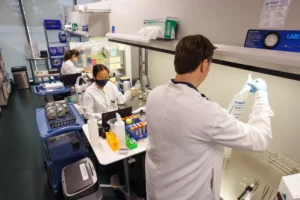 NPR WUNC | By Bradley George
NPR WUNC | By Bradley George
Bananas are the world’s most popular fruit. Americans eat nearly 27 pounds per person every year, according to the U.S. Department of Agriculture. A deadly fungus could destroy most of the world’s crops, but a company in Research Triangle Park is trying to save the banana through gene editing.
When it comes to growing bananas, RTP may not be the first place that pops in your head. But Matt DiLeo has a greenhouse full of them.
DiLeo is Vice President of Research and Development at Elo Life Systems, a biotechnology firm that’s exploring how gene editing can improve fruits and vegetables.
On a cloudy afternoon in early April, DiLeo opened the greenhouse door and stepped into a steamy atmosphere with a slightly floral odor. This greenhouse is packed floor to ceiling with banana trees. You’ve got to duck to keep the giant leaves from hitting your face. Some of the bananas are yellow, some are green, some are tiny and pink. DiLeo says they all share an important trait.
“Many of these are naturally resistant to the TR-4 fungus,” DiLeo said.
TR-4, also known as Fusarium Oxysporum, is a kind of fungus that attacks banana trees at the roots, killing the fruit. Fungicides and other chemicals can’t kill it, so farmers have few options when it invades their crop.
TR-4 was first discovered in Southeast Asia about 50 years ago. By the late 2010s, it was showing up in the soil of banana producing countries like Columbia and Costa Rica, which are home to the Cavendish banana — the variety you’ll find at your local grocery store.
DiLeo and his colleagues at Elo think they’ve found the solution to making a TR-4-resistant Cavendish banana. It’s called molecular farming — basically a form of gene editing.
Read more